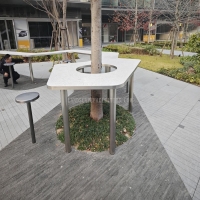Welcome to the website for landscape facilities products and knowledge.
How does the table perform in high-traffic environments like restaurants or event spaces?
In bustling restaurants and vibrant event spaces, tables face extraordinary challenges that ordinary furniture simply cannot withstand. The true measure of table performance in these high-traffic environments extends far beyond mere aesthetics, reaching into the realms of structural engineering, material science, and functional design. Commercial-grade tables achieve remarkable durability through advanced manufacturing techniques and carefully selected materials that undergo rigorous testing protocols.
The foundation of high-performance tables begins with their core construction. Manufacturers employ reinforced leg systems with additional bracing, thicker gauge metals, and advanced joining techniques that prevent wobble development over time. Table surfaces incorporate impact-resistant laminates, commercial-grade veneers, or solid materials like quartz composite that resist scratches, heat marks, and liquid penetration. These surfaces undergo testing simulating years of restaurant use within compressed timeframes, ensuring they maintain their appearance despite constant cleaning chemicals and physical impacts.
Structural integrity represents another critical consideration. High-traffic tables feature reinforced aprons and corner blocks that distribute weight evenly, preventing sagging or collapse when subjected to uneven loading. The best designs incorporate redundant support systems that create multiple failure points, meaning if one component weakens, others continue to provide stability. This engineering approach significantly extends the table's functional lifespan in environments where they're constantly moved, bumped, and rearranged.
Maintenance requirements separate commercial success stories from failures in restaurant and event applications. High-performance tables incorporate seamless edges that prevent dirt accumulation, non-porous surfaces that resist bacterial growth, and finishes that withstand aggressive cleaning chemicals without fading or deteriorating. The integration of these features reduces long-term ownership costs while maintaining hygienic standards essential in food service environments.
Beyond physical durability, successful high-traffic tables address practical operational needs. Weight considerations balance substantial feel with staff mobility requirements, while modular designs allow flexible configurations for different event types. Surface treatments reduce noise levels in busy dining rooms, and edge profiles minimize injury risks in crowded spaces. These nuanced design elements demonstrate how manufacturers have studied real-world usage patterns to create tables that perform optimally under continuous demand.
The evolution of table design for demanding environments continues to incorporate technological advancements and user feedback. From improved powder coatings that prevent rust in humid conditions to integrated cable management for event power needs, modern high-traffic tables represent sophisticated solutions to complex operational challenges. This ongoing innovation ensures that today's commercial tables not only withstand intense use but actively enhance the functionality of the spaces they occupy.
Related search:

Recommendation
An outdoor bar counter with stainless steel and terrazzo materials in an irregular shape